CA Foundation Maths Solutions For Chapter 3 Linear Inequalities Meaning & Introduction
- Inequalities are statements where two quantities are unequal but a relationship exists between them.
- These types of inequalities occur in business whenever there is a limit on supply, demand, sales, etc.
- For example, if a producer requires a certain type of raw material for his factory and there is an upper limit in the availability of that raw material, then any decision he takes about production should involve this constraint also.
- The value of the variables that satisfy an inequality is called the solution space and is abbreviated as S.S.
- The Objective function attains a maximum or a minimum value at one of the corner points of the feasible solution known as the extreme points of the solution set.
Read and Learn More CA Foundation Maths Solutions
Explanation & Summary of Graphical Method
It involves:
- Formulating the linear programming problem, i.e., expressing the objective function and constraints in the standardized format.
- Plotting the capacity constraints on the graph paper. For this purpose, normally two terminal points are required. This is done by presuming simultaneously that one of the constraints is zero.
- When constraints concern only one factor, then the line will have only one origin point and it will run parallel to the other axis.
- Identifying feasible regions and coordinates of corner points. Mostly it is done by breading the graph, but a point can be identified by solving simultaneous equation relating to two lines that intersect to form a point on the graph.
- Testing the corner point which gives maximum profit. For this purpose, the coordinates relating to the corner point should put in the objectives function and the optimal point should be ascertained.
For decision-making purposes, sometimes, it is required to know whether the optimal point leaves some resources unutilized. For this purpose, the value of coordinates at the optimal point should be put with constraint to find out which constraints are not fully utilized.
Generally, various type of questions that are asked are on various types:
- Identify the Inequality through the shaded region.
- Solving Inequalities and getting feasible points.
- Find the domain and Range of Inequality.
- Inequalities given and to identify the shaded region.
Special Note:
1. IF|m|>n then
m lies between (-∞, -n] U [ n, ∞)
2. IF |m| < n then
m lies between [ -n, n]
CA Foundation Maths Solutions For Chapter 3 Linear Inequalities Exercise 1
Question 1. Graphs of Inclinations arc drawn below

The common region [shaded part) shown in the diagram refers to the inequalities:
- 5x+ 3y ≤ 30, x + y ≤ 9, y≤ 1/2 x, y<x/2, x ≥ 0, y ≥ 0
- 5x + 3y. ≥ 30, x + y ≤ 9, y≥ x/3, y≤x/2, x ≥ 0,y ≥ 0.
- 5x + 3y > 30, x + y > 9, y<x/3, y>x/2, x> 0,y > 0,
- 5x + 3y > 30, x + y<9, y ≥ 9, y≤x/2, x ≥ 0, y ≥0
Solution: 2. 5x + 3y. ≥ 30, x + y ≤ 9, y≥ x/3, y≤x/2, x ≥ 0,y ≥ 0.
Take a point of the common satisfies all given inequations of option (2). region. Let the testing point be (5 : 3] of the region. This point
Question 2. If \(\left|x+\frac{1}{4}\right|>\frac{7}{4}\) then.
- \(x<\frac{-3}{2} \text { or } x>2\)
- \(x<-2 \text { or } x>\frac{3}{2}\)
- \(-2<x<\frac{3}{2}\)
- None of these
Solution: 2. \(x<-2 \text { or } x>\frac{3}{2}\)

Clearly \(\left(-\infty, \frac{-7}{4}\right)\) will lie in \(\)
Or in (7/4) ; ∞)
⇒ \(x+\frac{1}{4}<\frac{-7}{4}, \text { or },<\frac{-7}{4}-\frac{1}{4}\)
Orx < – 2
Andx \(x+\frac{1}{4}>\frac{7}{4} \text { or, } x>\frac{7}{4}-\frac{1}{4} \text { or } x>\frac{3}{2}\)
CA Foundation Maths Chapter 3 Linear Inequalities Solutions
Question 3. If \(\left|\frac{3 x-4}{4}\right| \leq \frac{5}{12}\), the solutions set is
1. \(\left\{x: \frac{19}{18} \leq x \leq \frac{29}{18}\right\}\)
2. \(\left\{x: \frac{7}{9} \leq x \leq \frac{17}{9}\right\}\)
3. \(\left\{x: \frac{-29}{18} \leq x \leq \frac{-19}{18}\right\}\)
4. None of these
Solution: 2. \(\left\{x: \frac{7}{9} \leq x \leq \frac{17}{9}\right\}\)
⇒ \(\left|\frac{3 x-4}{4}\right| \leq \frac{5}{12}\)
⇒ \(\frac{-5}{12} \leq \frac{3 x-4}{4} \leq \frac{5}{12}\)
Or, \(-\frac{5}{3} \leq 3 x-4 \leq \frac{5}{3}\) (Adding 4 to each term)
Or, \(\frac{7}{3} \leq 3 x \leq \frac{17}{3} \text {; or } \frac{7}{9} \leq x \leq \frac{17}{9}\)
Question 4. On solving the inequalities 6x + y > 18; x +4 y > 12; 2x + y > 10, we get the following situation:
- (0,18), (12,0), (4,2) & (2,6)
- (3,0), (0,3), (4,2) & (7,6)
- (5,0), (0,10), (4,2) & (7,6)
- (0,18), (12,0), (4,2), (0,0) & (7,6)
Solution: 1. (0,18), (12,0), (4,2) & (2,6)
1. For 6x + y = 18:
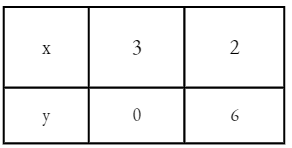
Point are (3;0);(2;6)
2. For x + 4y= 12:
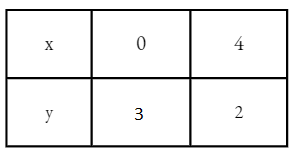
Point are (3 ; 0] ; [4 ; 2)
3. And 2x = y= 10:
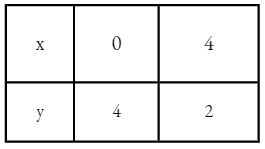
Point are (3 ; 4) & (4 ; 2]
Solving eqn. 6x + y = 18 & 2x + y = 10
Subtracting 4x = 8
∴ x = 2
Putting x = 2 in 2x + y = 10
We get
2 x 2 + y = 10
∴y = 6
Point Is (2 ; ,6)
Point (0; 8) satisfies eqn. 6x + y = 18
Point ( 12 ; 0) satisfies eqn x + 4y = 12 and 2x + y = 10
Point (2 ; 6) satisfies eqn 6x + y = 18 and 2x + y = 10
Question 5. A car manuals luring company manufactures cars of two types A and B. Model A requires 150 man-hours for assembling, 50 man-hours for palnlIni; and 10 man-hours for checking and testing. Model B requires 60 man-hours for assembling ’10 man-hours for painting and 20 man-hours for chocking and testing. There are available 30 thousand man-hours for assembling. 13 thousand man-hours for painting and 5 thousand man-hours for checking and testing. Express the above situation using linear inequalities, bet the company manufactures x units of type A model of car and y units of type II model of car.
Then, the inequalities are:
- 5x + 2y ≥1000; 5x + 4y ≥ 1300, x + 2y ≤ 500; x £ 0, y ≥ 0.
- 5x + 2y ≤ 1000; 5x + 4y ≤ 1300, x + 2y ≥ 500; x > 0, y ≥ 0.
- 5x + 2y ≤ 1000; 5x + 4y ≤ 1300, x + 2y ≤ 500; x > 0, y ≥ 0.
- 5x + 2y = 1000; 5x + 4y ≥ 1300, x + 2y = 500; x > 0, y ≥ 0.
Solution: 2. 5x + 2y ≤ 1000; 5x + 4y ≤ 1300, x + 2y ≥ 500; x > 0, y ≥ 0.
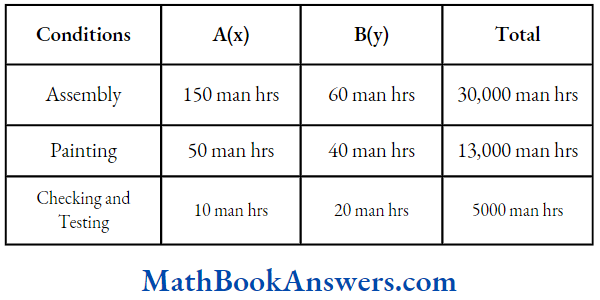
In equation Are
1 50x + 60y ≤ 30,000 ÷ 30 ⇒ 5x +2y ≤ 1,000
50x + 40y ≤ 13000] + 10 ⇒ 5x + 4y ≤ 1300
lO. + 20y ≤ 5000] ÷ 10 ⇒x + 2y ≤ 500
x ≥ 0 & y ≥ 0
Question 6. The rules and regulations demand that the employer should employ not more than 5 experienced hands to 1 fresh one and this fact is represented by: (taking an experienced person as x and a fresh person as y)
- \(y \geq \frac{x}{5}\)
- 5y < x
- 5y > x
- None of these
Solution: 1 & 3
1 Fresh with 5 experienced maximum employees.
y Fresh with 5y experienced maximum employees.
From Question
x ≥ 5 y ⇒ 5y ≥ x, OR, y ≥ \(x / 5\)
Question 7. The shaded region represents
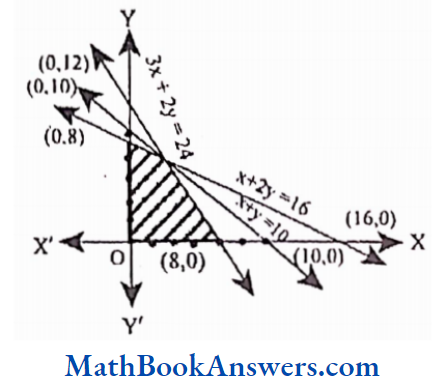
- 3x + 2y ≤ 24, x + 2y ≥ 16, x + y ≤ 10x, x ≥ 0,y ≥ 0
- 3x + 2y ≤24, x + 2y ≤ 16, x + y ≥ 10x, x ≥ 0, y ≥ 0
- 3x + 2y ≤ 24, x + 2y ≤16, x + y ≤ 10 x, x ≥ 0, y ≥ 0
- None of these
Solution: 3. 3x + 2y ≤ 24, x + 2y ≤16, x + y ≤ 10 x, x ≥ 0, y ≥ 0
Question 8. The shaded region represents
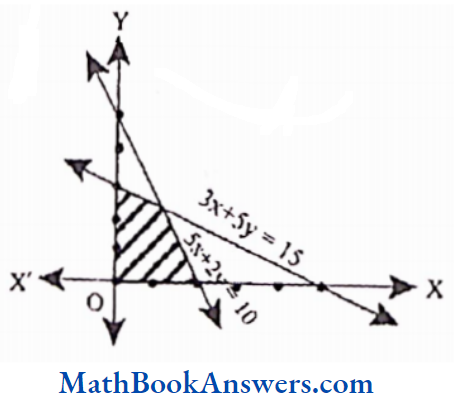
- 3x + 5y ≤15, 5x+ 2y ≥10, x,y ≥ 0
- 3x + 5y≤ 15, 5x + 2y< 10, x,y≥0
- 3x + 5y ≥ 15, 5x + 2y ≥ 10, x,y≥0
- None of these
Solution: 2. 3x + 5y≤ 15, 5x + 2y< 10, x,y≥0
Question 9. The shaded region represents
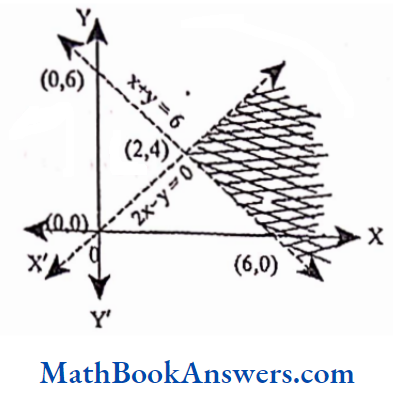
- x + y > 6, 2x- y > 0
- x + y < 6, 2x- y > 0
- x + y > 6, 2x- y < 0
- None of these
Solution: 1. x + y > 6, 2x- y > 0
Question 10. If a > 0 and b < 0, it follows that
- \(\frac{1}{a}>\frac{1}{b}\)
- \(\frac{1}{a}<\frac{1}{b}\)
- \(\frac{1}{a}=\frac{1}{b}\)
- None of these
Solution: 1. \(\frac{1}{a}>\frac{1}{b}\)
⇒ \(a>0 \Rightarrow \frac{1}{b}>0\)
⇒ \(\mathrm{b}<0 \Rightarrow \frac{1}{b}<0\)
∴ \(\frac{1}{a}>\frac{1}{b}\)
Question 11. The linear relationship between two variables in an inequality
- ax + by ≤ c
- ax. by ≤ c
- ax + by ≤ c
- ax + bxy ≤ c
Solution: 1. ax + by ≤ c
The linear equation is ax + by = c
Question 12. The solution of the inequality \(\frac{(5-2 x)}{3} \leq \frac{x}{6}-5\) is
- x ≥ 8
- x ≤ 8
- x = 8
- None of these
Solution: 1. x ≥ 8
⇒ \(\frac{5-2 x}{3} \leq \frac{x-5}{6}\)
Or \(\frac{5-2 x}{3} \leq \frac{x-30}{6}\)
Or, \(5-2 x \leq \frac{x-30}{7}\)
Or, 10 – 4x < x- 30
Or 10 + 30 ≤ N+ 4N
Or 50x ≥ 40
Or x ≥ 40
Question 13. Solution space of inequalities 2x + y < 10 and x-y < 5:
1. Includes the origin.
2. Includes the point (4,3) which one is correct?
- only 1
- Only 2
- Both 1 & 2
- None of the above
Solution: 1. only 1
(0,0) satisfies But (4 ; 3) does not satisfy 1
Question 14. On average, an experienced person does 5 units of work while a fresh one 3 units work daily but the employer have to maintain the output of at least 30 units of work per day.
The situation can be expressed as.
- 5x + 3y ≤ 30
- 5x + 3y≥30
- 5x + 3y = 30
- None of these
Solution: 2. 5x + 3y≥30
Let no. of experienced persons = x and No. of freshers = y
∴5x +3y > 30
Question 15. Find the range of real of x satisfying the inequalities 3x-2>7and 4x-13>15
- x > 3
- x > 7
- x > 7
- x < 3
Solution: 2. x > 7
3x – 2 > 7 ⇒ 3x > 9
∴ x > 3 __________________ (1)
4x > 15 + 23 ⇒ 4x > 28
∴ x > 7 _________________ (2)
Clearly from (1) and (2)
x > 7 satisfies both
Question 16. The shaded region represents
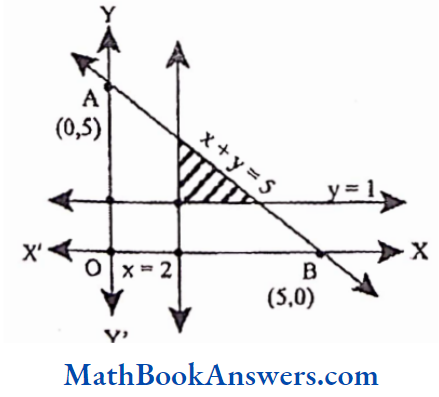
- x + y ≤ 5, x > 2, y ≤ 1
- x + y ≤ 5, x > 2, y ≥ 1
- x + y ≤ 5, x < 2, y ≥ 1
- None of these
Solution: 2. x + y ≤ 5, x > 2, y ≥ 1
Linear Inequalities Chapter 3 CA Foundation Answers
Question 17. The union forbids the employer to employ less than 2 experienced persons (x) for each fresh person (y), this situation can be expressed as
- x ≤ y/2
- y ≤ x/2
- y ≥ x/2
- None
Solution: 2. y ≤ x/2
No. of Fresh persons for x Experienced person = x/2
∴ x/2 ≥ y (given)
∴ y ≤ x/2
Question 18. The solution of the inequality 8x + 6 < 12x + 14
- (-2.2)
- (-2.0)
- (2, ∞)
- (-2,∞)
Solution: 4. (-2,∞)
8x + 6 < 12x+ 14
Or- 8 < 4x
Or- 2 < x
x > -2
Question 19. The graph of linear inequalities 7x + 9y < 63; x + y > 1; 0 < x s 6 and 0 <, y < 6 has been given below
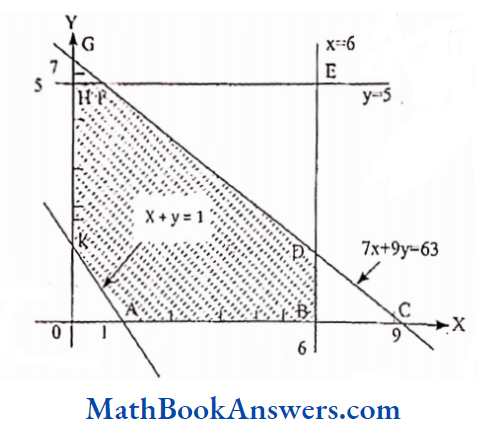
- BCDB and DEFD
- Unbounded
- HFGH
- ABDFHKA
Solution: 4. ABDFHKA
Common region is ABDFHKA
Question 20. Which of the following graph represents the equality x + y < 6 is
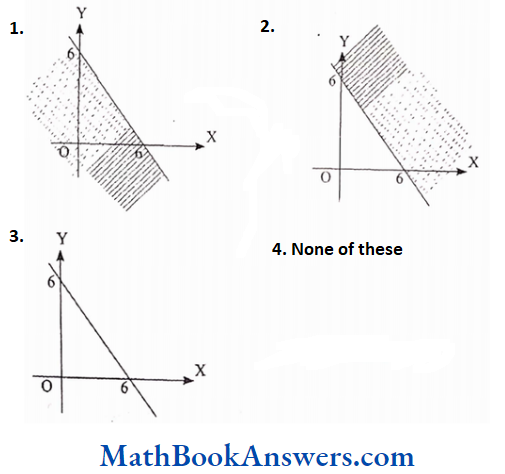
Solution: 1.
The graphical representation of x + y
Question 21. The graph of linear inequalities, x + y ≥ 5; x + y ≤ 5; 0 ≤ x ≤ 4 ami 0 ≤ y ≥ 2 is given below:
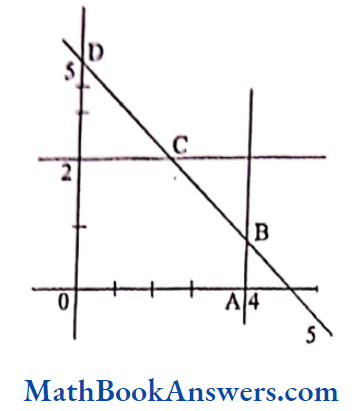
The common region of the inequalities will be:
- OABCED
- ECDE
- Line segment DC
- Line Segment BC
Solution: 3. Line segment DC
Question 22. The common region represented by the inequalities 2x + y ≥ 8, x + y ≥ 12, 3x + 2y ≤ 34 is
- Unbounded
- In feasible
- Feasible and bounded
- Feasible and Unbounded
Solution: 1. Unbounded
The graphical representation of x + y
2x + y = 8:
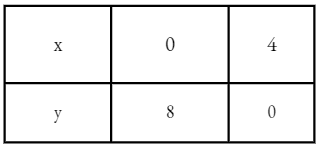
x + y= 12:
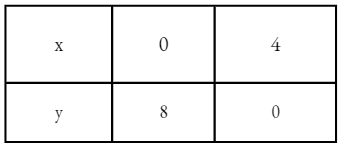
3. 3x+ 2y = 34:
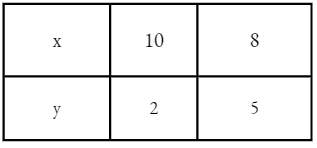
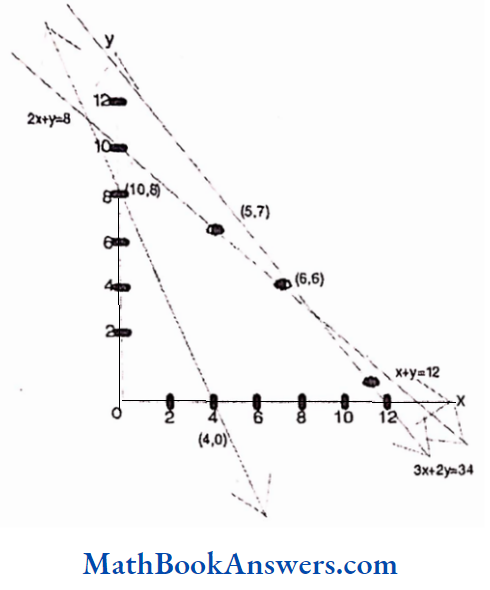
Question 23. Bylines x + y = 6, 2x- y = 2, the common region shown is the diagram refers to:
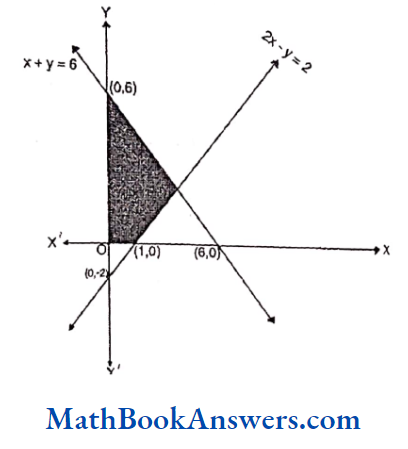
- x + y ≥ 6, 2x – y ≤ 2, x ≥ 0, y ≥ 0
- x + y ≤ 6, 2x- y ≤ 2, x ≥ 0, y ≥ 0
- x + y ≤ 6, 2x- y ≥ 2, x ≥ 0, y ≥ 0
- None of these
Solution: x + y ≤ 6, 2x- y ≤ 2, x ≥ 0, y ≥ 0
A point (1,1) (let) satisfies all inequations o
Question 24. The common region of x + y ≤ 6; x + y ≥ 3. Is shown by shaded region
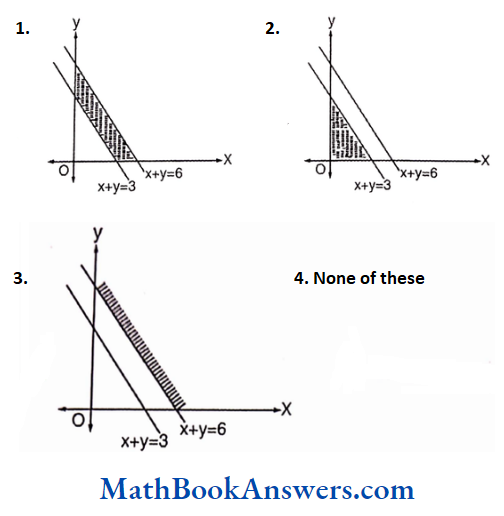
Solution: 1
A Point of the common region of the option (1) satisfies all given constraints x+y≤6 and x+y≥3
Question 25. The inequalities x1 + 2x2 ≤ 5; x1 + x2 ≥ 1; x1 > 0; x2 ≥ 0 represents the region.
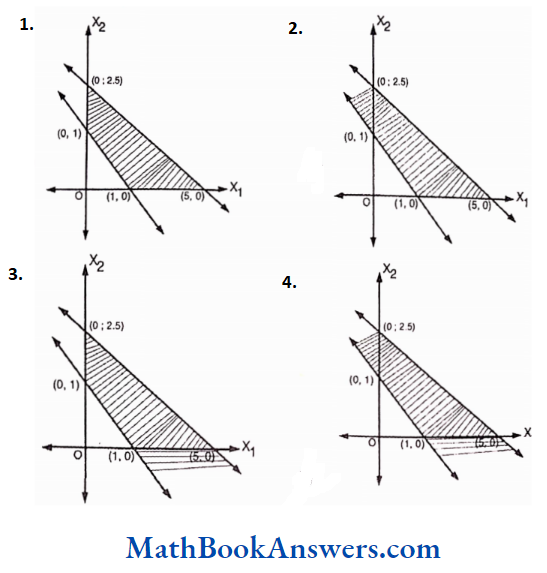
Solution: 1
Question 26. A dietitian wishes to mix two kinds of food so that the vitamin content of the mixture is at least 9 units of vitamin A, 7 units of vitamin B, 10 units of vitamin C, and 12 units of vitamin D. The vitamin content per kg. ofeach food is shown below.
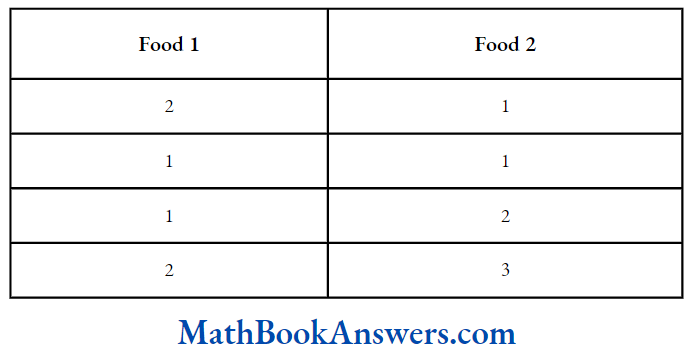
Assuming x kgs of food I is to be mixed with y kgs of food II the situation can be expressed as
- 2x + y ≤ 9; x + y ≤ 7; x + 2y ≤ 10; 2x + 3y ≤ 12; x> 0,y > 0
- 2x + y ≥ 9; x + y ≤ 7; x + 2y ≤ 10; 2x + 3y ≤ 12; x > 0, y > 0
- 2x + y ≥ 9; x + y ≤ 7; x + y < 10; x + 3y ≤ 12; x > 0, y > 0
- 2x + y ≥ 9; x + y ≥ 7; x + 2y ≥ 10; 2x + 3y ≥ 12; x > 0, y > 0
Solution: 4. 2x + y ≥ 9; x + y ≥ 7; x + 2y ≥ 10; 2x + 3y ≥ 12; x > 0, y > 0
At least → Minimum 30.
So, use ≥ Sign here.
Constraints are:
2x + y ≥ 9
x + y ≥ 7
x + 2y ≥ 1
2x + 3y ≥ 12
Question 27. The shaped region represented by the Inequalities 4x + 3y ≤ 60, y≥ 2 2x, x ≥ 3, x , 0, y ≥ 0
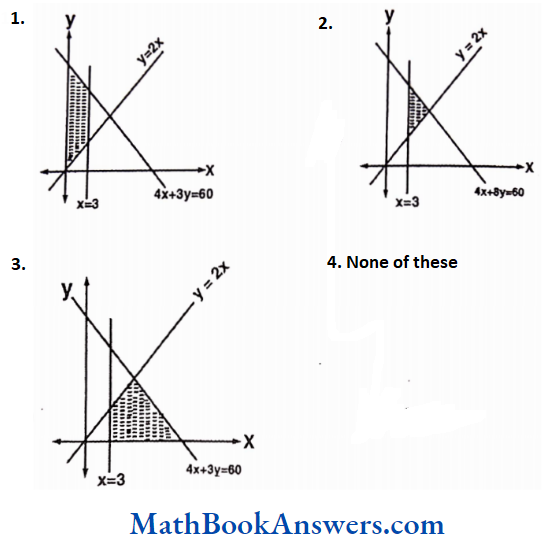
Solution: 2
Question 28. In the following diagram, the region represented by the inequalities x + 2y ≤ 10, x + y ≤ 6. x ≤ 4 & x ≥ 0, y ≥ 0 is :
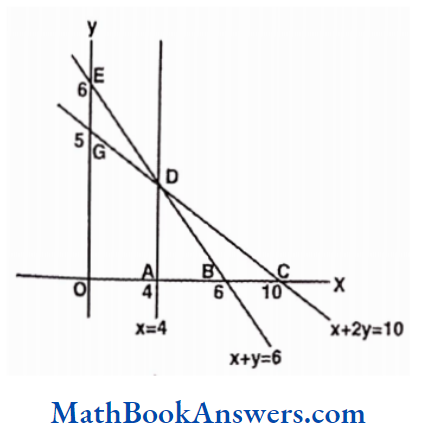
- OADGO
- ADC
- ACD
- DEG
Solution: 1. OADGO
Question 29. The liner relationship between two variables in an inequality
- ax + by ≤ c
- ax . by ≤ c
- axy + by ≤ c
- ax + bxy ≤ c
Solution: 1. ax + by ≤ c
Standard form of Linear Equation
is ax + by = c.
So; ax + by ≤ c is a Linear in equations.
Question 30. On Solving the Inequalities 5x + y ≤ 100, x + y ≤ 60, x ≤ 60, x ≥ 0, y ≥ 0, we get the following situation
- (0,0), (20, 0), (10, 50) & (0, 60)
- (0, 0), (20, 0), (0„ 100) & (10, 50)
- (0, 0), (60, 0), (10, 50) & (0,60)
- None of these
Solution: 1. (0,0), (20, 0), (10, 50) & (0, 60)
Question 31. An employer recruits experienced (x) and Ireslt workmen (y) under the condition that he cannot employ more than 11 people. X and Y can be related by Inequality
- x=y ≠ 11
- x + y ≤ 11, x≥0, y≥0
- x + y ≥ 11, x≥0, y≥0
- None of these
Solution: 2. x = y ≤ 11, x≥0, y ≥ 0
X + y≤ 11.
And x;y≥ 0
Question 32. The solution set of the inequations x + 2 > 0 and 2x – 6 > 0 is
- (-2.∞)
- (3, ∞)
- (-∞,-2)
- (-∞),-3)
Solution: 2. (3, ∞)
x + 2 > 0 ⇒ x > 2
⇒ x = {-l: 0. I, 2, 3, 4,}……………. (1)
And 2x – 6 > 0 ⇒ x > 3
⇒ x = (4 ; 5 ; 6 ; 7 }…………………… (1)
From (1) and (2); we get x = {4, 5, ………} satisfies both conditions.
Solution set = (3,∞ )
Question 33. The common region is represented by the following inequalities
L1 = X1 + X2 < 4
L2 = 2X1 – X2 > 6; x1 ≥ 0, X2 ≥ 0
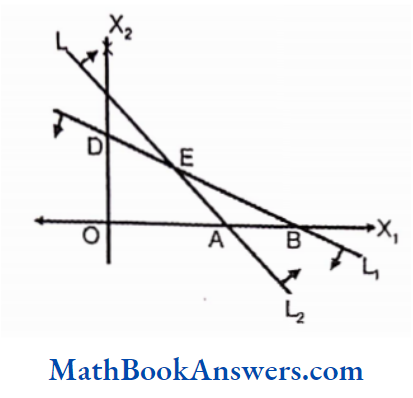
- OABC
- Outside of OAB
- Δ BCE
- Δ ABE
Solution: 4. Δ ABE
The common region is ΔABE.
Question 34. An employer recruits experienced (x) and fresh workmen (y) for his firm under the condition that he cannot employ more than 9 people, x and y can be related by inequality
- x + y ≠ 9
- x + y ≤ 9 x ≥ 0,y ≥ 0
- x + y ≥ 9x ≥ 0,y ≥ 0
- None of these
Solution: 2. x + y ≤9 x ≥ 0,y ≥ 0
Clearly ⇒ X + y ≤ 9 and x ;y ≤ 0
Question 35. On average, an experienced person does 5 units of work while a fresh one does 3 units of work daily but the employer has to maintain an output of at least 30 units of work per day. This situation can be expressed as
- 5x + 3y≤30
- 5x + 3y>30
- 5x+3y≥30 x ≥ 0, y ≥ 0
- None of these
Solution: 3. 5x+3y≥30 x ≥ 0, y ≥ 0
Let no. of experienced person be x.
∴ Work done by x persons = 5x
Let no of fresh ones be y
Work done by y persons = 3y
∴ 5x + 3y ≥30; x ≥0,y ≥0
Question 36. The rules and regulations demand that the employer should employ not more than 5 experienced hands to1 fresh one and this fact can be expressed as
- y ≥ x/5
- 5y ≤ x
- 5 y ≥ x
- Option (1) or (3)
Solution: 3. 5 y ≥ x
Experience person by x/5
Fresh person = y
Since he cannot employ more than
5 experienced hands to fresh one this can be represented as 5y ≥ x.
Question 37. The graph to express the inequality x + y ≤ 9 is
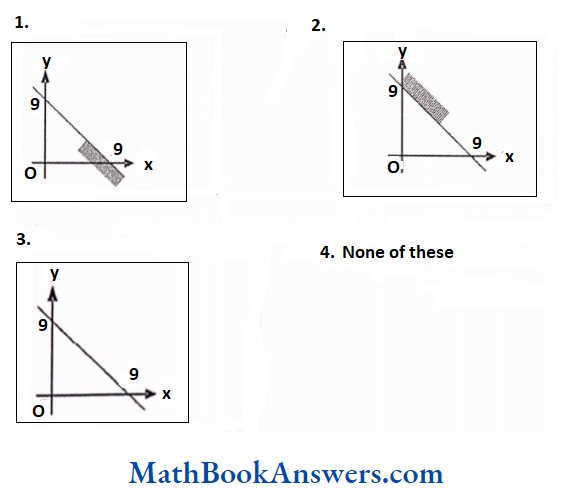
Answer: 1
Question 38. The graph to express the inequality 5x + 3y ≥ 30 is
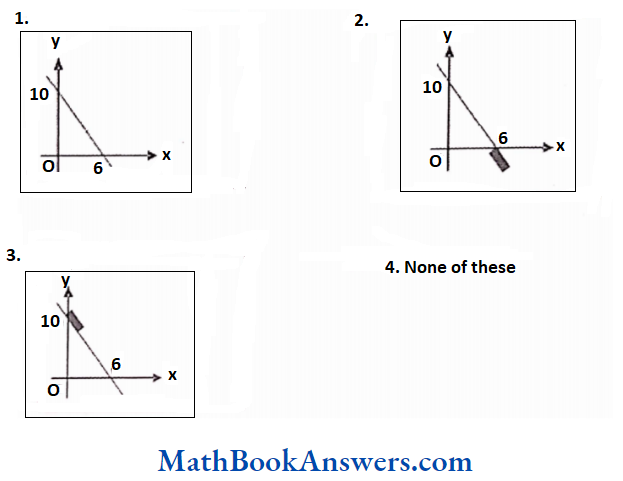
Solution: 3
Question 39. The graph to express the inequality \(\) is indicated by
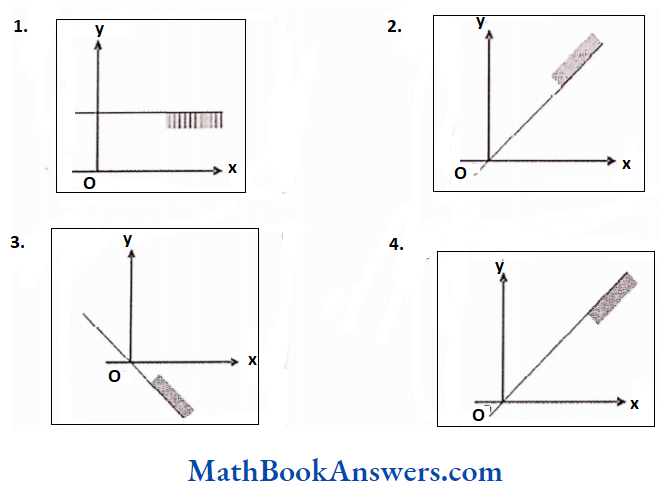
Solution: 4
Question 40. Graphs of the inequalities are drawn below
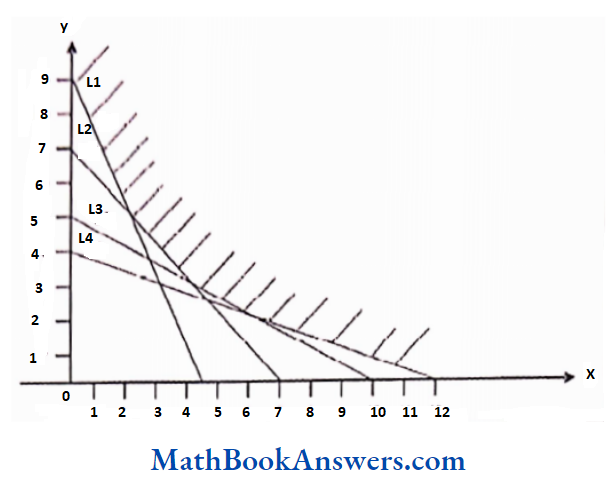
- 2x + y≤9, x + y ≥ 7, x + 2y≥ 10, x + 3 y ≥ 12
- 2x + y ≥ 9, x + y≤ 7, x + 2y ≥ 10, x + 3y≥ 12
- 2x + y > 9, x + y ≥ 7, x + 2y ≥ 10, x + 3y ≥ 12, x≥ 0,y ≥0
- None of these
Solution: 3. 2x + y > 9, x + y ≥ 7, x + 2y ≥ 10, x + 3y ≥ 12, x≥ 0,y ≥0
Take a point for example (8, 5) in a shaded region this satisfies all the equations
CA Foundation Maths Chapter 3 Detailed Solutions
Question 41. The common region satisfied by the inequalities L1: 3x + y > 6, L2: x + y > 4, L3: x + 3y > 6 and L4: x + y < 6 is indicated by
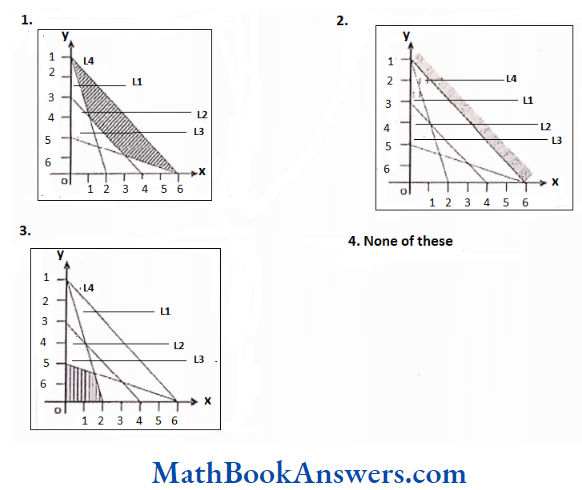
Solution: 1
Take a point for example (4, 2) in the shaded region this satisfies all the equations of
Question 42. The region indicated by the shading In the graph Is expressed by Inequalities
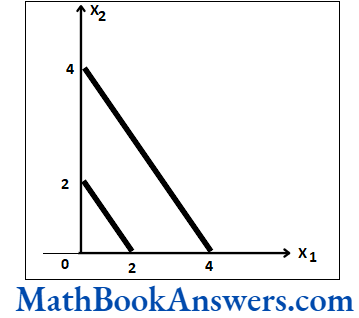
- x1+ x2≤2, 2x1 + 2x2 ≥ 8, x1 ≥ 0, x2 ≥0,
- x1 + x2≤ 2, x1x2 + x2 ≤ 4
- x1+x2 ≥ 2, 2x1+ 2x2≥8
- x1 + 2x2 ≤2, 2xi + 2x2 ≥8
Solution: 1. x1+ x2≤2, 2x1 + 2x2 ≥ 8, x1 ≥ 0, x2 ≥0,
Take a point for example (4, 2) which satisfies equation 2 of (a) & (1, 1) which satisfies equation 1
Question 43. The inequalities x1 ≥ 0, x2 ≥0, are represented by one of the graphs shown below:

Solution: 2
x1≥ 0, x2 ≥ 0, the shaded region will be the first quadrant
Question 44.
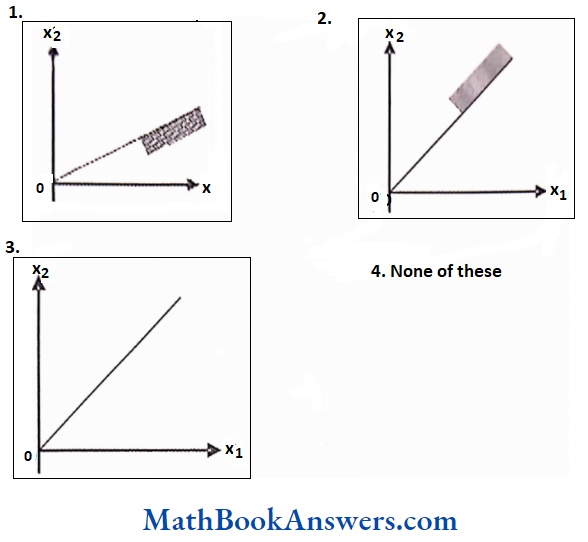
The region is expressed as
- x1 – x2> 1
- x1 + x2 < 1
- x1+ x2 > 1
- None of these
Solution: 3. x1 + x2 < 1
Question 45. The inequality x1 +2x2≤0 Is Indicated on the graph as

Solution: 1
Question 46.
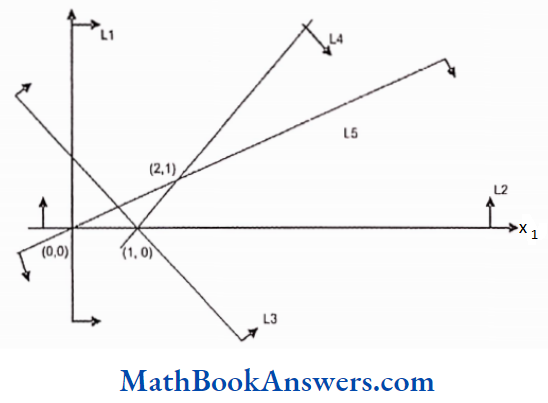
The common region indicated on the graph is expressed by the set of five inequalities
- L1: x1 ≥ 0, L2: x2 ≥ 0,L3: x1 + x2 ≤ 1, L4: x1 – x2 ≤ 1. L5: x1 +2x2 ≤0
- L1: x1 ≥ 0, L2: x2 ≥ 0, L3: x1 + x2 ≥ 1, L4: x1 – x2 ≥ 1, L5: x1 +2x2 ≤0
- L1: x1≤ 0, L2: x2 ≤ 0, L3: x1 + x2 ≥1, L4: x1 – x2 ≥ 1, L5: x1 +2x2 ≤0
- None of these
Solution: 2. LI: x1 ≥ 0, L2: x2 ≥ 0, L3: x1 + x2 ≥ 1, L4: x1 – x2 ≥ 1, L5: x1 +2x2 ≤0
Question 47. A firm makes two types of products: Type A and Type B. The profit on product A is Rs. 20 each and that on product B is Rs. 30 each. Both types are processed on three machines Ml, M2, and M3. The time required in hours by each product and the total time available in hours per week on each machine are as follows:
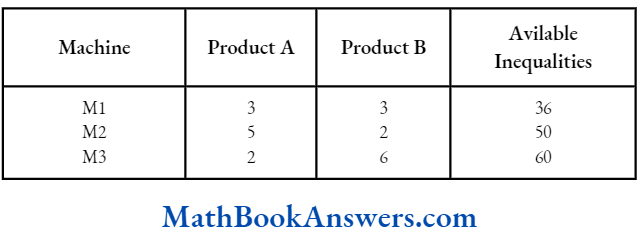
The constraints can be formulated taking x1 = number of units A and x2 = number of units of B
- x1 + x2 ≤ 12, 5x1 + 2x2 ≤ 50, 2x1 + 6x2 ≤ 60
- 3x1 + 3x2 ≥ 36, 5x1 + 2x2 ≤ 50, 2x1 + 6x2≤60, x1 ≥ 0, x2 ≥ 0
- 3x1 + 3x2 ≤ 36, 5x1 + 2x2≤ 50, 2x1 + 6x1 ≤ 60, x1 ≥0 ,x2 ≥ 0
- None of these
Solution: 3. 3x1 + 3x2 ≤ 36, 5x1 + 2x2 ≤ 50, 2x1 + 6x1 60, x1 ≥ 0,x2 ≥ 0
x1 = number of units A
x2 = number of units B
For machine 1, man capacity = 36 hrs
3x2 + 3x2 ≤ 36
x1 + x2 ≤12
For machine 2, max capacity = 50 hrs
5x1 + 2x2 ≤ 50
For machine 3, max capacity = 60 hrs
2x1 + 6x2 ≤ 60
x1 ≥ 0, x2 ≥0
Question 48. The set of inequalities L1: x1 + x2 ≤ 12, L2: 5x1 + 2x2 ≤ 50, L3: x1+ 3x2 ≤ 30, x1 > 0, and x2 >≥ 0 is represented by
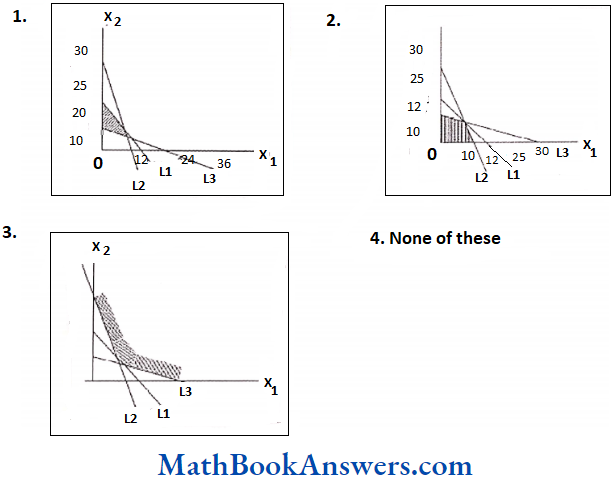
Solution: 2
Question 49. The common region satisfying the set inequalities x ≥ 0, y ≥0, L1: x + y ≤ 5, L2: x+ 2y ≤ 8 and L3: 4x + 3y ≥12 is indicated by
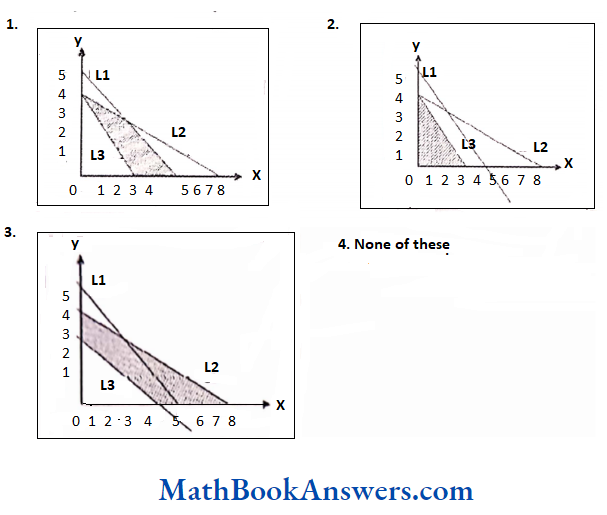
Solution: 1
Question 50. On solving the inequalities 2x+5y ≤ 20, 3x + 2 y ≤12,x≥ 0,y ≥ 0, we get following situation
- (0,0), (0,4), (4,0) and (20/11,36/11)
- (0,0), (10,0), (0,6) and {20/11,36/11)
- (0,0), (0,4), (4,0) and (2,3)
- (0,0), (10,0), (0,6) and (2,3)
Solution: 1. (0,0), (0,4), (4,0) and (20/11,36/11)
Question 51. On solving the inequalities 6x + y> 18, x + 4y> 12, 2x + y> 10, we get the following situation
- (0,18), (12,0), (4,2) and (2,6)
- (3,0), (0,3), (4,2) and (7,6)
- (5,0), (0,10), (4,2) and (7,6)
- (0,18), (12,0), (4,2), (0,0) and (7,6)
Solution: 3. (5,0), (0,10), (4,2) and (7,6)
Question 52. If x < 7, then
- -x < -7
- -x ≤ -7
- -x > -7
- -x ≥ -7
Solution: 3. -x > -7
X < 7 then
– x > -7
Sign change when multiplied by negative
Question 53. If -3x + 17 < -13, then
- x ∈ (10, ∞)
- x ∈ (10, ∞)
- x ∈ (-∞, 10)
- x ∈ (-10, 10)
Solution: 1. x ∈ (10, ∞)
-3x + 17 < – 13
-3x < – 30
3x>3y → x>10
→ x ∈ (10, ∞)
Question 54. Given that x, y, and b are real numbers and x < y, b > 0, then
1. \(\frac{x}{b}<\frac{y}{b}\)
2. \(\frac{x}{b} \leq \frac{y}{b}\)
3. \(\frac{x}{b}>\frac{y}{b}\)
4. \(\frac{x}{b} \leq \frac{y}{b}\)
Solution: 1. x < y , b > 0
⇒ \(\frac{1}{b}<\frac{y}{b}\)
Since b is positive
Question 55. If x is a real number and |x| < 5, then
- x ≥ 5
- -5 < x < 5
- x ≤-5
- -5 ≤ x ≤ 5
Solution: 2. -5 < x < 5
|x|<5
Question 56. If x and a are real numbers such that a > 0 and |x| > a, then
- x ∈ (-a, ∞)
- x ∈ (∞,-a)
- x ∈ (-a, a)
- x ∈ (-∞,-a) U (a, ∞)
Solution: 4. x ∈ (-∞,-a) U (a, ∞)
a > 0 |x| > a
Question 57. If |x – 1| > 5, then
- x ∈ (-4,6)
- x ∈ (- ∞,-4) U (6, ∞)
- x ∈ (-4,6)
- x ∈ (-∞, 4) U (6, ∞)
Solution: 3. x ∈ (-4,6)
|x-1| > 5 then
X-1 < – 5 or x-1 > 5
X < – 4 or x > 6
How To Solve Linear Inequalities In CA Foundation
Question 58. If |x + 2| < 9, then
- x ∈(-7, 11)
- x ∈ (-11, 7)
- x ∈ (—∞, -7)U (11,∞)
- x ∈ (-∞, 7)U (11,∞)
Solution: 2. x ∈ (-11, 7)
|x + 2|<9
-9 < x + 2 < 9
-9-2<x<9-2
-11 < x < 7
x ∈ (-11, 7)
Question 59. The linear inequality representing the solution set given in the following
- |x| < 5
- |x| > 5
- |X| ≥ 5
- |x| ≤ 5
Solution: 3. |x| ≥ 5
Question 60. The solution set of the inequation |x +2| ≤ 5 is
- (-7.5)
- [-7.3]
- [-5.5]
- (-7,3)
Solution: 2. (-7,3)
Question 61. If\(\frac{|x-2|}{x-2} \geq 0\) then
- x ∈[2, ∞)
- x ∈ (2, ∞)
- x ∈ (-∞, 2)
- x ∈(-∞, 2]
Solution: 2. x ∈ (2, ∞)
Question 62. If|x + 3| ≥ 10, then
- x ∈ (-13, 7]
- x ∈(-13, 7]
- x ∈ (-∞, – 13)U (7, ∞)
- x ∈(-∞, – 13) U (7, ∞)
Solution: 4. x∈ (-∞,-13)U(7,∞)
Question 63. A small manufacturing firm produces two types of gadgets A and B, which are first processed in the foundry, then sent to the machine shop for finishing. The number of man-hours of labour required in each shop for the production of each unit of A and B, and the number of man-hours the firm has available per week are as follows:

The profit on sale A is 30 per unit as compared with % 20 per unit of B. This situation can be expressed as
- 10x + 6y ≤ 1000, 5x + 4y ≤ 600, x,y ≥0
- 10x + 6y ≤ 1000, 5x + 4y≥600, x,y ≥ 0
- 10x + 6y ≤ 1000, 5x + 4y ≤ 600, x, y ≤ 0
- None of these
Solution: 1. 10x + 6y ≤ 1000, 5x + 4y ≤ 600, x,y ≥0
Question 64. A company is making two products A and B. the cost of producing one unit of products A and B are ?60 and respectively. As per the agreement, the company has to supply at least 200 units of product B to its regular customers. One unit of product A requires one machine hours whereas product B has machine hours available abundantly within the company. Total machine hour available for product A are 400 hours. One unit of each product A and B requires one labour hour each and total of 500 labour hours are available. This situation can be expressed as
- x + y≤500, x + 4y ≤ 600, x,y ≥ 0
- x + y ≤ 500, x ≤ 200, y ≤ 400, x,y ≥ 0
- x + y ≤ 500, x + 2y ≤ 600, x,y ≥ 0
- None of the above
Solution: 2. x + y ≤ 500, x ≤ 200, y ≤ 400, x,y ≥ 0
CA Foundation Maths Linear Inequalities Practice
Question 65. A firm manufactures 3 products A, B and C. The profit are K2 and respectively. The firm has 2 machines and below is the required processing time in minutes for each machine on each product:
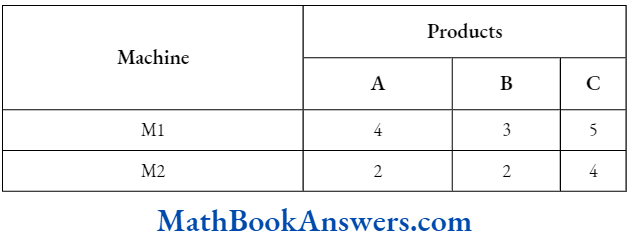
Machines M1 and M2 have 2000 and 2500 machine minutes respectively. The firm must manufacture 100 A’s, 200 B’s and 50 C’ s but not more than 150 A’s. This situation can be expressed as
- 4x + 3y+ 5z≤ 2000, 2x – 2y + 4z ≤ 2000, 100 ≤ x ≤ 150, y ≥ 200, z ≥ 50, x ≥ 0,y ≥ 0,z ≥ 0.
- 4x + 3y + 5z ≤ 2000, 2x – 2y + 4z ≤ 2000, 100 ≤ y ≤ 150, x ≥ 200, z ≥ 50, x≥0,y≥0, z≥0.
- 4x + 3y + 5z ≤ 2000, 2x + 2y + 4z ≤ 2500, 100 ≤ x ≤ 150, y ≥ 200, z ≥ 50 x ≥0, y ≥ 0, z ≥ 0
- None of the Above
Solution: 3. 4x + 3y + 5z ≤ 2000, 2x + 2y + 4z ≤ 2500, 100 ≤ x ≤ 150, y ≥ 200, z ≥ 50 x ≥0, y ≥ 0, z ≥ 0
Question 66. A firm manufactures two types of products A and B sells them at a profit of 32 on type A and 33 on type B. Each product is processed on two machines M1 and M2. Type A requires one minutes of processing time on Mi and two minutes of M2 ; type B requires one minute on Mi and one minutes on one M2. The machine Mi is available for not more than 6 hours 40 minutes while machine M2 is available for 10 hours during any working day. This situation can be expressed as
- x + y≤ 400, 2x + y≤ 600, x ≥0,y≥ 0
- x – y ≤ 400, 2x + y ≥ 600, x ≥ 0, y ≥ 0
- x + y ≥ 400, 2x + y ≤ 600, x ≥ 0,y≥ 0
- None of the above
Solution: 1. x + y≤ 400, 2x + y≤ 600, x ≥0,y≥ 0
Question 67. A rubber company is engaged in producing three types of tyers. A, B and C. each type requires processing in two plant, plant 1 and Plant 2. The capacities of the two plant, in number of tyres per day, are as follows:
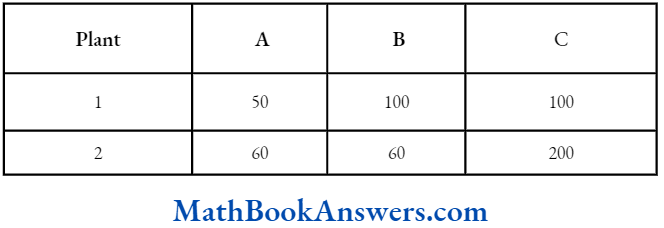
The monthly demand for tyres A, B and C is 2500, 3000 and 7000 respectively. If plant 1 cost 3 2500 per day, and plant II cost 33500 per day to operate. This situation can be expressed as
- 50x + 60y≤ 2500, 100x + 60y ≥ 3000,100x +200y ≤ 7000, x,y≥ 0
- 50x + 60y ≥ 2500, 100x + 60y ≤ 3000, 100x +200y ≤ 7000, x,y≥ 0
- 50x + 60y ≥ 2500, 100x + 60y ≥ 3000, 100 x +200y ≥ 7000, x. y ≥ 0
- None of these
Solution: 3. 50x + 60y ≥ 2500, 100x + 60y ≥ 3000, 100 x +200y ≥ 7000, x. y ≥ 0
Question 68. A company sells two different products A and B. The two products are produced in the production process and are sold in two 68. different markets. The production process has a total capacity of 45000 man-hours. It takes 5 hours to produce a unit of A and 3 hours to produce a unit of B. The market has been surveyed and company officials feel that the maximum number of units of A that can be sold is 7000 and that of B is 10,000. If the profit is 60 per unit for the product A and K 40 per unit for the product B, This situation can be expressed as
- 5x+ 3y ≤45000, x ≥ 7000, y≤ 10,000, x,y ≥0
- 5x+3y≤ 45000, x ≤ 7000, y≤ 10,000, x,y ≥0
- 5x+3y≥ 45000, x ≤ 7000, y≤10,000, x,y ≥ 0
- None of these
Solution: 2. 5x+3y≤ 45000, x ≤ 7000, y≤ 10,000, x,y ≥0
Question 69. To maintain his health a person must fulfill certain minimum daily requirements for several kind of nutrients. Assuming that there are only three kinds of nutrients – calcium, protein and calories and the person’s diet consists of only two food items, I and 11, whose price and nutrient context are shown in the table below:
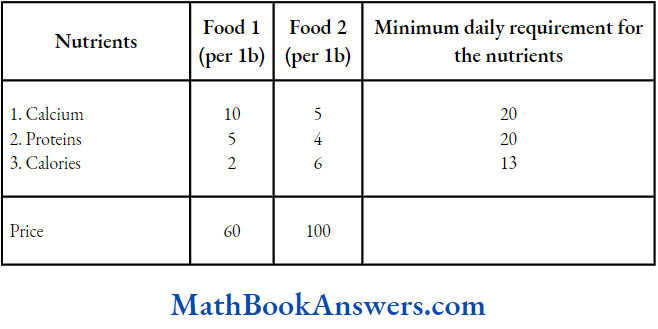
This situation can be expressed as
- 10x + 5y ≥ 20, 5x + 4y ≥ 20, 2x + 6y > 13, x, y ≥ 0.
- 10x + 5y ≤20, 5x + 4y ≥ 20, 2x + 6y > 13, x,y ≥ 0.
- 10x + 5y ≥ 20, 5x + 4y ≤ 20, 2x + 6y > 13, x, y ≥ 0.
- None of these
Solution: 1. 10x + 5y ≥ 20, 5x + 4y ≥ 20, 2x + 6y > 13, x, y ≥ 0.
Question 70. Manufacturers can produce two products, A and B, during a given time period, each of these products requires four different manufacturing operations: grinding, turning, assembling and testing. The manufacturing requirements in hours per unit of products A and B are given below
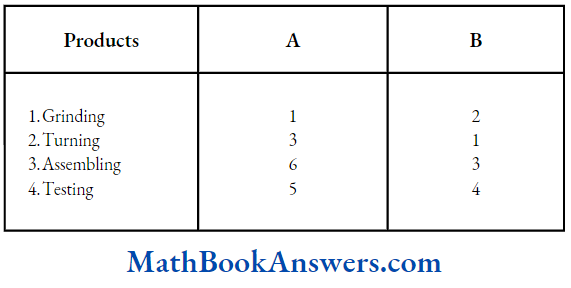
The available capacities of these operations in hours for the Riven lime period are: grinding 30; turning 60. assembling 200; testing 200. The contribution to profit is V20 for each unit of A and <30 for each unit of B. the firm can sell all that it produces at the prevailing market price. This situation can be expressed as
- x + 2y ≥ 30, 3x + y ≤ 60, 2x + 6y ≥ 13, x,y ≥0
- x + 2y ≤ 30, 3x + y ≤ 60, 2x + 6y ≤ 13, x,y ≥0
- x + 2y ≤ 30, 3x + y ≤ 60, 6x + 3y ≤ 200, 5x + 4y ≤ 200, x,y ≥0
- None of these
Solution: 3. x + 2y ≤ 30, 3x + y ≤ 60, 6x + 3y ≤ 200, 5x + 4y ≤ 200, x,y ≥0
Question 71. Vitamins A and B are found in two different foods F1 and F2. One unit of food Fi contains 2 units of vitamin A and 3 units of vitamin B. One unit of food F2 contains 4 units of vitamin A and 2 units of vitamin B. One unit of food F1 and F2 cost 25 respectively. The minimum daily requirements for a person of vitamin A and B is 40 and 50 units respectively. Assuming that anything over the daily minimum requirement of vitamins A and B is not harmful. This situation can be expressed as’
- 2x + 4y > 40, 3x + 2y < 50, x > 0, y > 0
- 2x + 4y > 40, 3x + 2y > 50, x ≥ 0, y ≥ 0
- 2x + 4y < 40, 3x + 2y> 50, x > 0, y > 0
- None of these
Solution: 2. 2x + 4y ≥ 40, 3x + 2y ≥ 50, x ≥ 0, y ≥ 0
Chapter 3 CA Foundation Maths Answer Key
Question 72. An automobile manufacturer makes automobiles and trucks in a factory that is divided into two shops. Shop A, which performs the basic assembly operation, must work 5 man-days on each truck but one 2 man-days on each automobile. Shop B, which performs finishing operations, must work 3 man-days for each automobile or truck that it produces. Because of men and machine limitations, shop A has 180 man-days per week available while shop B has 135 man-days per week. This situation can be expressed as
- 5x + 2y ≤ 180, 3x + 3y≤ 135, x ≥ 0, y ≥ 0
- 5x+ 2y ≥ 180, 3x + 3y ≤ 135, x ≥ 0, y ≥ 0
- 5x + 2y ≤ 180, 3x + 3y ≥135, x ≥ 0, y ≥ 0
- None of these
Solution: 1. 5x + 2y ≤ 180, 3x + 3y≤ 135, x ≥ 0, y ≥ 0
Question 73. A firm manufactures two products, each of which must be processed through two departments, 1 and 2. The hourly requirements per unit for each product in each department, the weekly capacities in each department, selling price per unit, labor cost per unit, and raw material cost per unit are summarized as follows
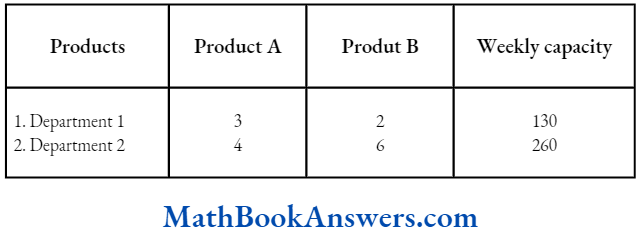
This situation can be expressed as
- 3x+ 2y ≥ 130, 4x + 6y ≤ 260, x ≥0, y ≥ 0
- 3x + 2y ≤ 130, 4x + 6y ≥ 260, x ≥ 0, y ≥ 0
- None of these
Solution: 3. 3x + 2y ≤ 130, 4x + 6y ≤ 260, x ≥ 0, y ≥ 0
